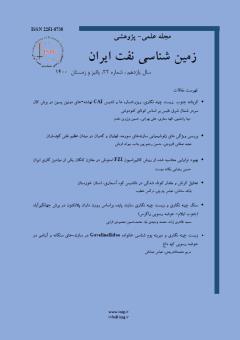بهبود تراوایی محاسبه شده از روش کالیبراسیون FZI استونلی در مخزن کنگان یکی از میادین گازی ایران
محورهای موضوعی : Petrophysics
1 - وزارت علوم تحقیقات و فناوری
کلید واژه: تراوایی, کنگان, خوشه بندی چند تفکیکی بر پایه گراف, کالیبراسیون FZI استونلی.,
چکیده مقاله :
تراوایی توانایی جریان سیال برای یک سنگ متخلخل بوده که تخمین درست آن کاری به شدت دشوار است. دو روش معمول و مرسوم محاسبه تراوایی آنالیز مغزه و چاه آزمایی است، اما اندازه گیری تراوایی از طریق مغزه در تمامی چاه های یک میدان در آزمایشگاه، فرآیندی شدیداً زمانبر و هزینه بر بوده و همچنین در بعضی چاه ها منجمله؛ چاه های افقی امکان مغزه گیری وجود ندارد. چاه آزمایی نیز به دلایلی نظیر؛ هزینه های بالا و توقف تولید در بازه انجام تست صرفه اقتصادی ندارد. لذا ارائه و توسعه روش هایی مبتنی بر نگارهای چاه پیمایی معمول و DSI جهت تخمین تراوایی بدلیل هزینه های کم، جامع و در دسترس بودن اهمیت فراوانی دارد. به این منظور در این پژوهش، در مرحله اول تراوایی به کمک روش خوشه بندی چند تفکیکی بر پایه گراف (MRGC) تخمین زده شد و با تراوایی مغزه مقایسه گردید. در مرحله دوم تراوایی به روش کالیبراسون FZI استونلی محاسبه و در نهایت با تراوایی مغزه مقایسه گردید. در مرحله سوم به جهت بهبود تراوایی محاسبه شده از روش کالیبراسیون FZI استونلی جهت غلبه بر هتروژنی مخزن از روش خوشه بندی چند تفکیکی بر پایه گراف (MRGC) در ابتدا واحدهای جریانی مشخص شدند، در ادامه برای هر واحد جریانی بصورت مجزا تراوایی از روش کالیبراسیون FZI استونلی محاسبه گردید و در نهایت با ترکیب کردن تراوایی های محاسبه شده یک نگار دقیق از تراوایی در چاه مورد مطالعه تخمین زده شد. مشاهده شد که ضریب همبستگی تراوایی های تخمین زده شده با تراوایی مغزه در روش خوشه بندی چند تفکیکی بر پایه گراف (R2=77)، کالیبراسیون FZI استونلی (R2=47) و روش بهبود داده شده (R2=84) بدست آمد. روش مذکور توانست 37 درصد تراوایی محاسبه شده در مرحله قبل را بهبود بخشد و به عنوان بهترین روش جهت محاسبه تراوایی در مخزن کنگان چاه مورد مطالعه معرفی می گردد.
Permeability in fluid flow is for a porous rock, which is exactly what causes the problem. core analysis and well testing are two most commonly used methods of permeability measurement, but in-vitro measurement of permeability by applying core analysis on all wells in a specific field is very time consuming and costly and even impossible when dealing with Horizontal wells. Wells testing, on the other hand, is not cost-effective for reasons such as; High costs and zero production during the testing process. Therefore, thanks to their low cost, comprehensiveness and availability, permeability estimation methods developed according to conventional logs land DSI diagrams are of critical importance. Taking this into account, in the present study, permeability was first estimated using multi-resolution graph-based clustering (MRGC) and the results were compared with permeability rates obtained from core analysis. In the second stage, permeability was measured by ST-FZI method and the results were compared with permeability rates obtained from core analysis. In the third stage, the multi-resolution graph-based clustering (MRGC) method was used to improve the permeability calculated by the ST-FZI method and overcome the reservoir heterogeneity. First the flow units were identified, and then the ST-FZI method was applied on each flow unit to calculate permeability and finally the calculated permeabilities were combined to obtain an accurate permeability graph of the studied well. The correlation coefficients of permeability rates estimated via core analysis in the multi-resolution graph-based clustering method (R2 = 77), ST-FZI method (R2 = 47) and improved method (R2 = 84) were measured. The afore-mentioned method was able to improve the permeability calculated in the previous step by 37% and was recognized as the best permeability measurement method in the Kangan reservoir of the well subjected to study.

